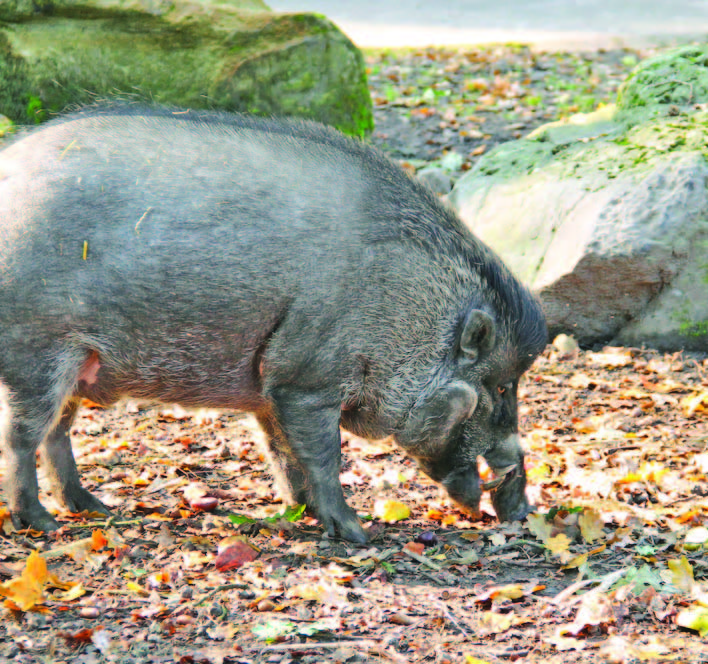The Visayan warty pig (Sus cebifrons) goes by several local names: the Cebu bearded pig, baboy ilahas, baboy do mor, manggalisak banban, biggal, and bakatin, according to the Ultimate Ungulate website. It also has two subspecies depending on the island it lives on: the Cebu warty pig (Sus cebifrons cebifrons) and the Negros warty pig (Sus cebifrons negrinus), which refers to the species found on Negros and Panay, reported Belle Piccio in a 2016 article for Choose Philippines.
Mohawked Mammal
Dark gray in color, the Visayan warty pig is sparsely covered in bristly hairs. This is generally darker in females and light brown or silver in males. They have a tuft of hair that grows between the ears; in Panay, this tuft can grow like a punk mohawk, a long mane that extends from the head to the tail and even hang over the pig’s face, covering the eyes. They also have a recognizable white stripe that runs over the bridge of the nose behind the mouth. And of course, the species gets its name from the facial warts that grow on the snout of the males.

The Visayan warty pig can grow up to 100 centimeters long, with the males larger and heavier than the females. Males can grow up to 63 centimeters in shoulder height, while females stand from 35 to 45 centimeters. Females weigh around 20 to 35 kilograms, while males are 35 to 80 kilograms.
The pigs breed late in the year, and it takes around 118 days to gestate. The sows give birth in the dry season early the following year, from January to March. Each litter can number two to four piglets each, who are breastfed for six months.
They have been rarely observed in the wild, but in captivity, they reach sexual maturity by one year to 14 months. It is likely, however, that they reach sexual maturity in the wild in two to three years. The Visayan warty pig’s lifespan is around 10 to 15 years.

As forest dwellers, they have an omnivorous diet: fruit, leaves, tubers, earthworms, and possibly other insects. They appear to have a role in dispersing the seeds of some plant species through their droppings, based on information from Ultimate Ungulate.
They are, however, known to enter agricultural zones and farms to plunder crops. As a result, farmers tend to view them as pests to be hunted, according to Wildscreen Arkive. [Here at Animal Scene, we challenge readers to look at animals as doing only what comes naturally to them, and that while some people look at some animals as pests, other animals also view people the same way. It’s a matter of perspective, one we hope becomes kinder the more we know. -Ed.]
Endangered
So far, Arkive.org notes around 41 individuals in the captive population. The website also states that the Philippines has the more species of wild pigs than any other nation. Like other conservation organizations, it also says that most of these are severely endangered due to habitat loss and hunting. This underscores the need for greater efforts at conserving biodiversity around the Visayan islands.

Hogging the conservation limelight
Less than a century ago, the Visayan warty pig ranged over the dense forests of six of the Visayan islands. These days, habitat loss and hunting have restricted its movements to just three islands: Panay, Negros, and to a lesser extent, Masbate. In 2008, the International Union for Conservation of Nature placed the pig on its Red List of Threatened Species; even with exact numbers of individuals living in the wild unavailable, the loss of 95 percent of their former range was enough to sound the alarm on its status. Also, they have been exposed to diseases through domestic pigs and by breeding hybrids with these domestic species.
Some foreign organizations have stepped in to help with conservation efforts. The Rotterdam Zoo has taken to breeding the Negros warty pig, while Panay warty pigs are being bred at the San Diego Zoo. There are also other efforts from the Crocolandia Foundation, and the Negros Forests and Ecological Foundation, Inc.
The most recent news of a pig born in captivity comes from 2016, when a Visayan warty piglet was born at Newquay Zoo in Cornwall in February 2016 — it’s the largest zoo in Cornwall and also houses the Philippine spotted deer.
Other, older efforts come from the Visayan Warty Pig Conservation Program, established in 1991.
The program has the long-term aim of reintroducing the pigs into their former habitat, though it stands to reason these areas may need reforesting and restoration.

Local captive breeding and rescue centers can also be found in Negros in Siliman University, in addition to the Negros Forests and Ecological Foundation. The Philippine Biodiversity Conservation Foundation, Inc. (PBCFI) has included the warty pig in its programs. In 2015, Negros artists created some pillows in the shape of the warty pig to raise funds and awareness, according to a 2015 Facebook post by the PBCFI. Meanwhile, Panay’s College of Agriculture and Forestry has established another center.
This appeared in Animal Scene magazine’s February 2019 issue.






